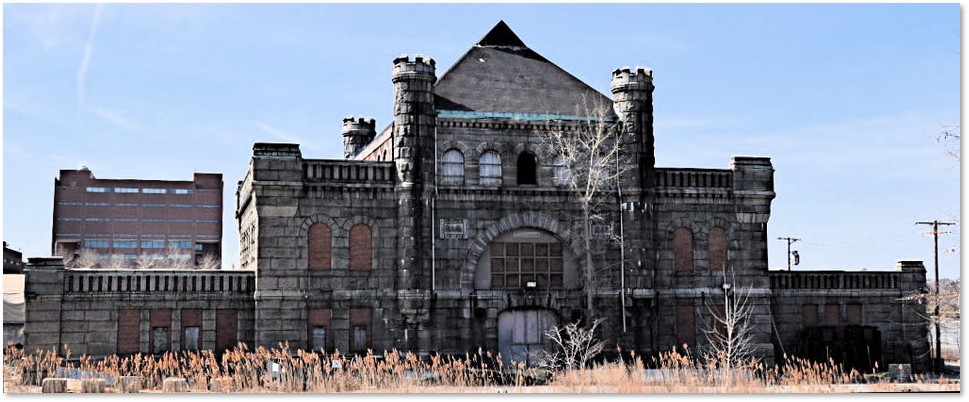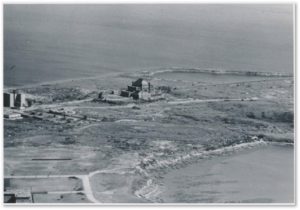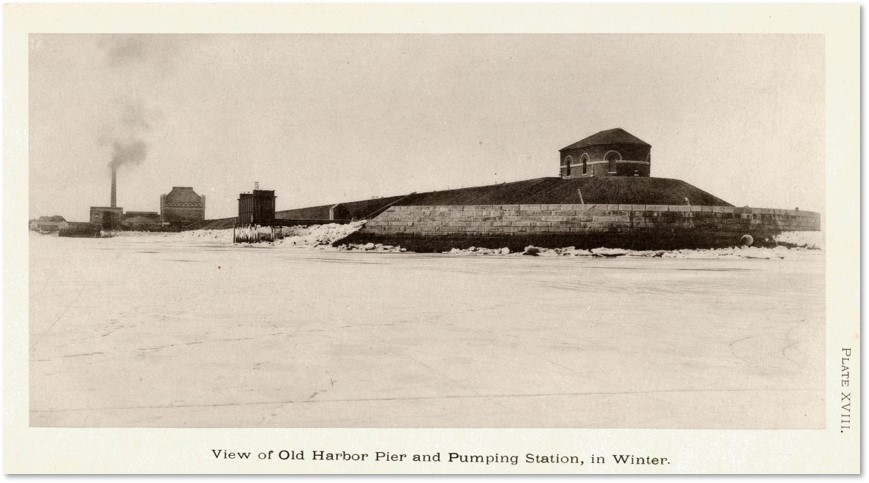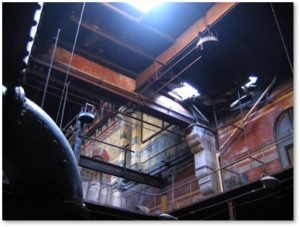On December 24, 1991, the Massachusetts Water Resources Authority ended an age-old practice of dumping sewer sludge directly into Boston Harbor. This reversed a process that polluted water and beaches and earned the sobriquet a “Harbor of Shame.”
As Boston celebrates – perhaps “acknowledges” is a better word – this anniversary, we should take a look at one of the vestiges of that history.
It’s Not a Castle
The gray granite building squats on Columbia Point like a dark old toad brooding amid the glamorous new buildings of the University of Massachusetts Boston, the John F. Kennedy Library, the Massachusetts Archives, and the Edward M. Kennedy Institute for the United States Senate.
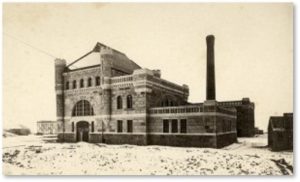 In fact, you have to drive right past this abandoned and derelict structure on your way to the latter three institutions. Doing so can lead to a surprise and exclamations of, “What the heck is that?” here’s a hint:
In fact, you have to drive right past this abandoned and derelict structure on your way to the latter three institutions. Doing so can lead to a surprise and exclamations of, “What the heck is that?” here’s a hint:
It wasn’t a castle.
Nor a prison.
It wasn’t an asylum.
Or even an armory.
The Calf Pasture Pumping Station
The answer seems not to match its appearance. The Calf Pasture Pumping Station comes from a time when public buildings, even those that performed the most basic and un-glamorous of functions, were designed to be statements of civic pride. Believe it or not, in 1883 any organized disposal of sewage, no matter how rough, represented an improvement because it replaced just letting the mess drop onto the nearest shoreline.
For an excellent history of Boston’s Water and Sewerage Systems, see pages 84 and 85 of “The Atlas of Boston History” by Historian Nancy Seasholes. In this amazing book, Ms. Seasholes does a comprehensive job that should answer any questions you might have.
Abandoned since 1968, the Calf Pasture Pumping Station broods behind a chain link fence, as if shunned by the more modern buildings around it.
Boston’s City Architect
City Architect George Albert Clough designed the Calf Pasture Pumping Station for the city’s Main Drainage System on what is now Columbia Point. Boston’s early settlers pastured their calves on Columbia Point after they were weaned from their mothers. Farmers sent the cows to the Cow Pasture on Dorchester Neck, now South Boston.
Mr. Clough served as the city’s architect of large public projects and institutional buildings, including the John Adams Courthouse, the Fields Corner Municipal Building, the Boston English High, Boston Latin School, and the Prince School in the Back Bay.
The original front door faces Mount Vernon Street (Columbia Point, not Beacon Hill) and informs the visitor with the date of completion, 1883. Plaques on either side say “B.I.S.” for Boston Improved Sewerage, the original name of the Main Drainage System.
A Confusion of Styles
Typically described as “Richardsonian Romanesque” in style, the building, along with the two gatehouses on either side, seems more Gothic Revival to me. What else would you call the narrow castellated turrets that ventilated the steam-driven pumps, the walls of rough-cut, rock-faced granite slabs, the square towers at the corners of the façade, and the round towers with crenelated tops that bracket the front door?
Romanesque elements include decorative detailing in lighter granite on belt courses, window and door frames, and the castellated cornice. The building has become so dirty, however, that this polychromy can be difficult to make out. Only the rounded arches over the front door and the side windows really speak to Richardsonian Romanesque.
The L-shaped building’s central section has a very steeply pitched gable-on-hip roof, while the four remaining sections have flat roofs. Some copper flashing can still be seen on the main facade. The roof on the one-story ell, which housed the boiler room, is a gable-on-gable, featuring a row of clerestory windows.
The Pumping Process
The Main Drainage Works gathered raw sewage from Boston’s neighborhoods and took it to Columbia Point. According to Nancy Seasholes, The Calf Pasture Pumping Station:
“…pumped the sewage up thirty-five feet so that it would flow through an outfall sewer, then 160 feet down a shaft to a tunnel under the harbor to Squantum, and then to reservoirs on Moon Island where, still raw and untreated, it was released into the harbor at ebb tide.”
Unfortunately, the sewage often washed back in with the next high tide to be deposited on the shoreline and beaches.
The Calf Pasture Pumping Station, a new and modern facility that boasted the largest pumps in the world, officially began operating on New Year’s Day, 1885. It continued operations until 1968, when the Deer Island Sewage Treatment Plant opened. (That’s the facility in the harbor with big tanks that look like upright eggs.) The MWRA maintained it for a while as a back-up facility for the Deer Island Plant during bad weather.
The Boston Main Drainage system eventually became the Metropolitan Sewer District, which served 23 municipalities by 1895.
The Inside View
The University of Massachusetts now owns the structure and the more valuable land on which it and its two outbuildings stand. Unfortunately, the university has allowed it to deteriorate despite assertions of an intent to preserve the property.
The doors have been boarded up, the windows bricked in, and vines grow over the exterior walls. That awful chain-link fence keeps the curious from entering and, presumably. from being injured.
Before that fence went up, however, people did go inside and take photographs. You can see pictures of the interior taken in 2011 by UMass Boston’s Associate Provost Peter Langer on the UMass Boston website page on the Histories of the Calf Pasture Pumping Station. Additional interior photos are available on the Desolate Metropolis website. The interior decoration is still remarkably vibrant after 51 nears of disuse and neglect. Here the colorful Richardsonian Romanesque design comes through most clearly.
An Endangered Resource
Meanwhile, Preservation Massachusetts has named the structure one of the state’s most endangered historic resources. Their organization’s press release called the Calf Pasture Pumping Station a
“…visible manifestation of one of Boston’s great technological innovations in the field of metropolitan public utilities – a regional system of interceptor sewers to keep raw sewage out of the Back Bay and Boston’s inner harbor.”
The Calf Pasture Pumping Station was added to the National Register of Historic Places in 1990. The Boston Landmarks Commission accepted the Calf Pasture Pumping Station petition for further study in 2018, so the building could yet be designated as a Boston Landmark. This distinction could, give UMass Boston more incentive to do something constructive with the structure—or even to renovate it for another use.
The Calf Pasture Pumping Station
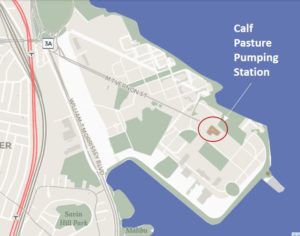 435 Mount Vernon Street
435 Mount Vernon Street
Dorchester, MA
Driving past the Calf Pasture Pumping Station takes little navigation. Just follow the directions to the John F. Kennedy Presidential Library and Museum. Once past UMass Boston, you will see something that looks like a derelict castle and that’s it.
You can look around from the outside but can’t get too close because of the chain link fence. You don’t have to get too near, though, to see how decrepit the building has become.
